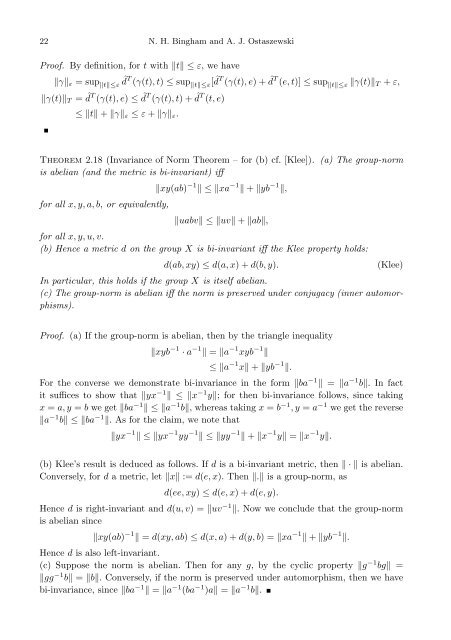Normed versus topological groups: Dichotomy and duality
Normed versus topological groups: Dichotomy and duality
Normed versus topological groups: Dichotomy and duality
You also want an ePaper? Increase the reach of your titles
YUMPU automatically turns print PDFs into web optimized ePapers that Google loves.
22 N. H. Bingham <strong>and</strong> A. J. OstaszewskiProof. By definition, for t with ‖t‖ ≤ ε, we have‖γ‖ ε = sup ˆdT ‖t‖≤ε (γ(t), t) ≤ sup ‖t‖≤ε [ ˆd T (γ(t), e) + ˆd T (e, t)] ≤ sup ‖t‖≤ε ‖γ(t)‖ T + ε,‖γ(t)‖ T = ˆd T (γ(t), e) ≤ ˆd T (γ(t), t) + ˆd T (t, e)≤ ‖t‖ + ‖γ‖ ε ≤ ε + ‖γ‖ ε .Theorem 2.18 (Invariance of Norm Theorem – for (b) cf. [Klee]). (a) The group-normis abelian (<strong>and</strong> the metric is bi-invariant) ifffor all x, y, a, b, or equivalently,‖xy(ab) −1 ‖ ≤ ‖xa −1 ‖ + ‖yb −1 ‖,‖uabv‖ ≤ ‖uv‖ + ‖ab‖,for all x, y, u, v.(b) Hence a metric d on the group X is bi-invariant iff the Klee property holds:d(ab, xy) ≤ d(a, x) + d(b, y).(Klee)In particular, this holds if the group X is itself abelian.(c) The group-norm is abelian iff the norm is preserved under conjugacy (inner automorphisms).Proof. (a) If the group-norm is abelian, then by the triangle inequality‖xyb −1 · a −1 ‖ = ‖a −1 xyb −1 ‖≤ ‖a −1 x‖ + ‖yb −1 ‖.For the converse we demonstrate bi-invariance in the form ‖ba −1 ‖ = ‖a −1 b‖. In factit suffices to show that ‖yx −1 ‖ ≤ ‖x −1 y‖; for then bi-invariance follows, since takingx = a, y = b we get ‖ba −1 ‖ ≤ ‖a −1 b‖, whereas taking x = b −1 , y = a −1 we get the reverse‖a −1 b‖ ≤ ‖ba −1 ‖. As for the claim, we note that‖yx −1 ‖ ≤ ‖yx −1 yy −1 ‖ ≤ ‖yy −1 ‖ + ‖x −1 y‖ = ‖x −1 y‖.(b) Klee’s result is deduced as follows. If d is a bi-invariant metric, then ‖ · ‖ is abelian.Conversely, for d a metric, let ‖x‖ := d(e, x). Then ‖.‖ is a group-norm, asd(ee, xy) ≤ d(e, x) + d(e, y).Hence d is right-invariant <strong>and</strong> d(u, v) = ‖uv −1 ‖. Now we conclude that the group-normis abelian since‖xy(ab) −1 ‖ = d(xy, ab) ≤ d(x, a) + d(y, b) = ‖xa −1 ‖ + ‖yb −1 ‖.Hence d is also left-invariant.(c) Suppose the norm is abelian. Then for any g, by the cyclic property ‖g −1 bg‖ =‖gg −1 b‖ = ‖b‖. Conversely, if the norm is preserved under automorphism, then we havebi-invariance, since ‖ba −1 ‖ = ‖a −1 (ba −1 )a‖ = ‖a −1 b‖.
















